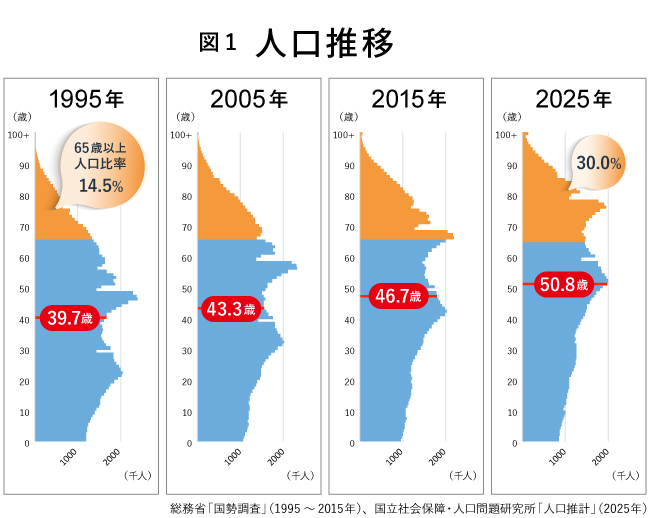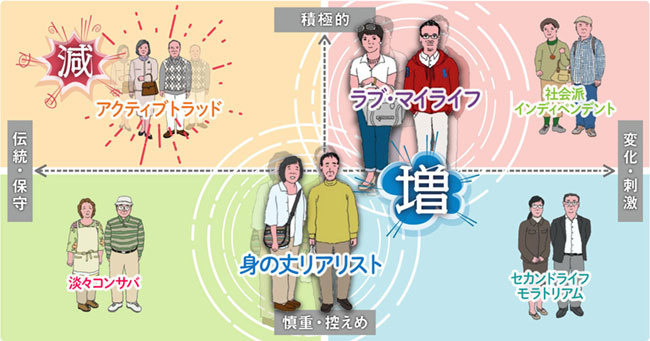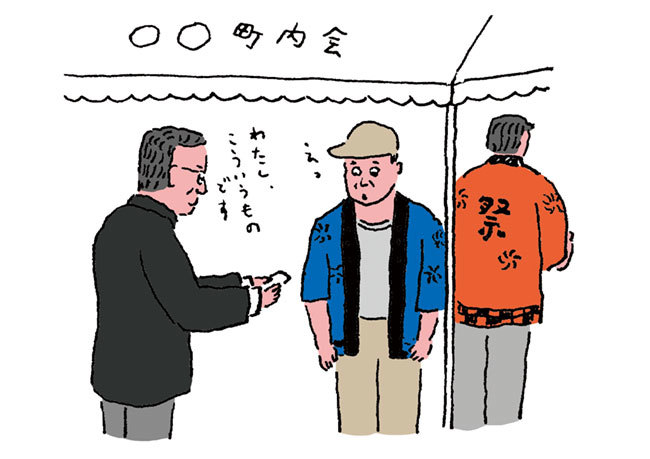Note: This website was automatically translated, so some terms or nuances may not be completely accurate.
Japan's "Super-Super" Aging Society: What Will Happen to Seniors?
This concludes our five-part series "Rethinking Senior Marketing Today." In this final installment, I'd like to briefly consider the future trajectory of seniors in Japan, a nation leading the world in aging demographics.
In five years, one in two people will be 50 or older

Figure 1 tracks population trends in 10-year increments. The red line within the graph represents the median age—the age that divides the population exactly in half.
About 20 years ago, half the population was under 40. However, the 2015 census, the most recent data available, shows half the population is now 47 or older. According to the National Institute of Population and Social Security Research, this median age is projected to exceed 50 by 2023. In just five years, one in two people will be 50 or older. It really makes you realize how much of a "nation of adults" Japan truly is...
According to the United Nations definition, a society is considered an "aging society" when the proportion of people aged 65 and over (the aging rate) reaches 7% or more, a "high-aged society" at 14% or more, and a "super-aged society" when it exceeds 21%. Japan surpassed the 7% threshold in 1970, meaning it entered an "aging society" 48 years ago. It surpassed 14% to become an "aged society" in 1994, and exceeded 21% to become a "super-aged society" in 2007.
According to the latest population estimates available as of October 2017, the aging rate stood at 27.7%. While there appears to be no defined term beyond "super-aged society," if we were to arbitrarily name Japan's rapidly approaching 28% threshold, perhaps it could be called a "super-super aged society."
That said, in this era often called the "100-year life," while society may indeed be a "super-super aged society," the people living within it can no longer be described solely through stereotypical images of "elderly people." Considering statements like that of the Japan Gerontological Society, which notes that "today's elderly are physically, mentally, and health-wise 5 to 10 years younger than the elderly of the past," the image of the elderly will likely continue to change significantly.
If we assume the era of 100-year lifespans becomes reality, even 50-year-olds are barely at the halfway point of their lives, and those in their 60s and 70s still have plenty of life ahead of them.
The "New Humans" of yesteryear become seniors. That artist's nostalgic hits!
There was a generation called the "New Humans" in the 1980s. Looking into its origin and definition, it was a new term used to describe young people at the time as having "sensibilities, values, and behavioral norms different from the past." While there are various theories, it often refers to those born in the 1960s.
In my personal view, I recall that the "New Humans" generation of the 1980s was often somewhat mocked by older generations as a peculiar generation they couldn't understand. As someone from the generation following in their footsteps, I looked at them with admiration, thinking, "Adults seem to have so much fun!" They created interesting cultures and trends distinctly different from before, and aided by the booming economy, they built a glamorous world. As an aside, I also remember laughing heartily when a popular comedy duo, considered representative of the New Humans, smashed a TV camera during a live broadcast.
Now, some members of that "New Humanity" generation have already entered the age we define as "senior" (defined by the VR Aging Lab as 55 to 74 years old). Those born in 1960 are 58 this year. Having spent their twenties during the peak of the bubble economy, they are sometimes called the "Bubble Generation." A notable difference from other generations is their tendency to still maintain strong consumer spending power. Recently, I often see promotions that seem specifically targeted at this generation.
For example, magazines targeting those in their 50s and older are being launched one after another. In the past, such publications were few and far between, and even when they existed, they often focused solely on health information. Now, however, many propose fashion and lifestyle content in general.
A prime recent example is Takarajimasha's "MonoMaster," a mook that performed so well it announced its transition to a monthly publication starting this September. According to Takarajimasha, it targets "former city boys who experienced the heyday of Ivy, Trad, and DC brands and avidly read magazines like 'Popeye,' 'Men's Club,' and 'Takarajima'" (Source: Takarajimasha Press Release ).

At our VR Aging Lab, as part of our research, we recently conducted a survey asking participants about their current preferences—similar to how we previously asked about music, fashion, and TV shows they liked in their youth.
To identify characteristics and differences by birth decade, we surveyed individuals born from the 1950s to the 1990s, receiving responses from over 1,700 people. The survey focused on open-ended responses. While we are currently organizing and compiling the data for analysis and cannot present the full picture yet, we will share some raw data excerpts and the trends observed from them.
The first thing we noticed was that when looking at "current favorite music" from the data of those born in the 1950s (currently 59-68 years old) and the 1960s (currently 49-58 years old), so-called "enka" (traditional Japanese ballads) hardly appeared at all.
While the open-ended nature allows for variation in expression, among the 300+ respondents born in the 1950s, only about 7 clearly identified "enka" as their current favorite genre. Among the nearly 500 respondents born in the 1960s, only 2 did so. Expanding the category to include "Showa-era pop songs" might yield slightly more, but it remains a minority preference.
Since many respondents answered that they "still listen to songs they listened to in the past," tracing their roots to the "music they liked in their teens" revealed prominent Western music like The Beatles, The Carpenters, and Simon & Garfunkel, along with folk songs and group sounds. Additionally, a notable characteristic of those born in the 60s is that more people cited the genre called "New Music."
On the other hand, while a fair number of both those born in the 1950s and 1960s mentioned music classified as "Showa-era pop songs" from their teens, it became clear that very few said they listened to "enka" (traditional Japanese ballads).
This suggests that what will be called "nostalgic melodies" in the future will likely change with the times. Among those who listed "enka" among the music they listen to now, a few mentioned that "as I got older, enka started to resonate with me." However, people who feel this way are truly a handful. "Nostalgic melodies" are the music they frequently listened to or loved during their most impressionable years. For today's 50s and 60s generation, that music is not enka, but rather The Beatles, The Carpenters, The Tigers, Momoe Yamaguchi, Takuro Yoshida, Yuming, Motoharu Sano, and Southern All Stars.
Following this, we plan to proceed with analysis comparing other age groups and examining other categories like fashion. Once trends become apparent, we will announce them in some form.
What will happen to the senior values segment?
So, looking at the Senior Values Segment, what will happen in the future?

Explanations for each "Senior Values Segment" can be found here
At VR Aging Lab, we formulate hypotheses considering social environments like politics and economics, along with the historical context in which individuals were raised.
First, as the previously mentioned "Bubble Generation" approaches senior age, we anticipate an increase in individuals with strong consumption desires and a preference for aggressive actions. Consequently, the Love My Life segment is expected to expand for some time.
Conversely, we also anticipate a continued rise in "reality-based realists" who cannot afford large expenditures. A major factor is the raising of the pension eligibility age. While extended employment is mandated for companies and labor shortages mean more people are working until around age 70, significant challenges remain in senior employment. These include a substantial drop in income after retirement and difficulty finding desired job types.
Furthermore, the first cohort covered by the Equal Employment Opportunity Act for Men and Women will be around 55 this year. While it's said that few ultimately remained in managerial positions throughout their careers, they undoubtedly laid the groundwork for women's advancement in society today, and many likely led work-centered lives.
Consequently, we can expect a temporary increase in "moratorium women" – those who spent their working lives commuting between home and work, lacking opportunities to build private communities.

Socially conscious independents may increase in 15 to 20 years, when the current generation around age 40—often called the Lost Generation due to the employment ice age—becomes seniors. This generation experienced neither the economic growth period as working adults nor witnessed the collapse of Japan's traditional employment system, fostering a mindset independent of companies. The fact that many social entrepreneurs come from this generation speaks to this.
Conversely, Active Trades are expected to decline. The inheritance tax law revisions have increased the burden, and more people are likely to lose the financial breathing room provided by inherited assets.
However, not everyone seeks novelty; relatively traditional and conservative individuals are expected to maintain a steady presence. Consequently, Active Trads may converge with the similarly minded Calm Conservatives.
The above is merely a hypothesis based on the assumption that the current six segments persist into the future.
Perhaps in five or ten years, previously unrecognized senior types will emerge, or the six classifications themselves may be completely overhauled.
As we hurtle toward a "super-super" aged society, I want to keep closely tracking—as a personal matter—how the next generation of seniors will change, how society will evolve, and what kind of marketing and communication strategies can be developed based on that. After all, I myself am approaching the age where I'll soon be called a "senior."

Video Research Ltd. Hito Research Institute "VR Aging Lab"
A senior research team launched by Video Research Ltd.'s think tank, the Human Research Institute, aiming to revitalize the senior market. It conducts research activities, disseminates information, and provides consulting services to companies on senior marketing, capturing the realities of seniors to apply to marketing efforts.
Hito Research Institute: http://www.videor.co.jp/hitoken/#anc2
Was this article helpful?
Newsletter registration is here
We select and publish important news every day
For inquiries about this article
Back Numbers
Author

Tomiko Tsushima
Video Research Ltd.
Human Research Institute
Principal Researcher
After working as a strategic planner at a research firm and a foreign-affiliated advertising agency, he joined Video Research Ltd. He is involved in lifestyle research, primarily focusing on understanding the trends and attitudes of the senior demographic and exploring effective approaches, supporting companies in solving their challenges.


